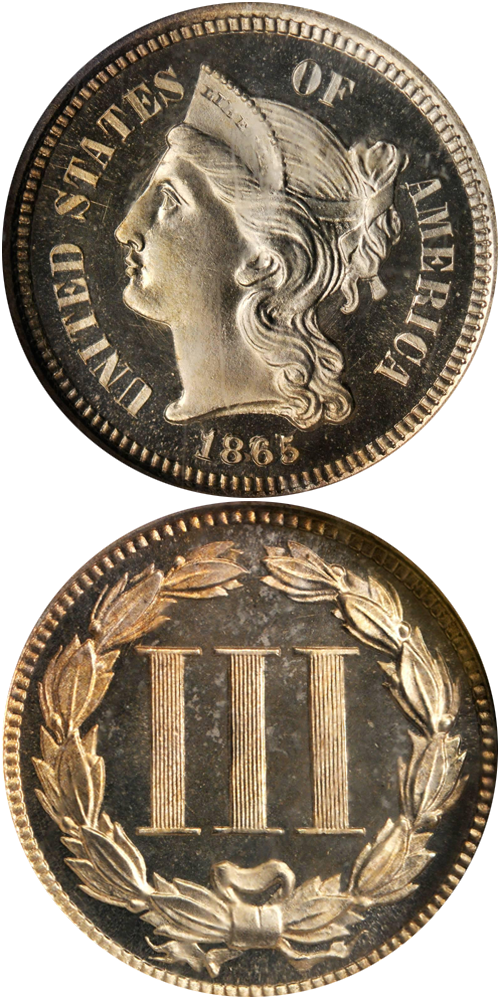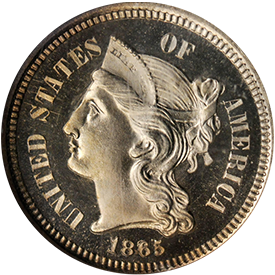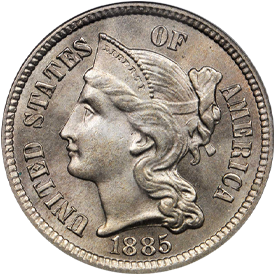Designed by: James Barton Longacre
Issue Dates: 1865-1889
Composition: 75% copper and 25% nickel, an alloy commonly called "nickel"
Diameter: 17.9 mm
Weight: 1.94 grams (29.94 grains)
Edge: Plain
Business Strike Mintage: 31,332,527
Proof Mintage: 56,000 (estimated)
Nickel three-cent pieces were intended to serve as small change in circulation and as a substitute for the silver three-cent pieces, in an era in which the government was releasing little new silver coinage into circulation. Silver coin shipments were suspended during the Civil War and were not fully resumed until the early 1870s. Despite great expectations, as evidenced by a mintage of over 11 million the first year, the pieces were not well accepted, and from that point the mintages declined. In later years very few were struck.
The obverse design consists of Miss Liberty wearing a diadem inscribed LIBERTY, her hair neatly arranged. UNITED STATES OF AMERICA and the date surround. The reverse is an adaptation of the laurel wreath earlier used on the 1859 Indian cent, enclosing the Roman numeral III.
Numismatists desiring circulated examples of the nickel three-cent piece will find that coins from Good through AU grades are readily available for most issues of the decade beginning with the 1865 date. Uncirculated coins are also seen with regularity, although truly superb pieces are scarce. Those desiring Proofs will have a better selection among later issues, which were produced in large quantities. Business strikes are apt to be lightly impressed in areas, a result of the hard nickel alloy not completely filling all of the recesses in the dies.
Further Reading
The series of nickel three-cent pieces is an interesting one for the collector. It is rather brief in duration, contains no "impossible" rarities (although several are elusive), and pieces can be collected in high grades without much difficulty, assuming that one has a satisfactory balance in a checking account. As is the case with certain other issues, most nickel three-cent pieces go to those forming type sets, numismatists who seek but a single example. However, over the years numerous specialists have formed date runs.
Why were nickel three-cent pieces made? There were several reasons. In 1865, when they were first issued, the Civil War had ended, but silver coins were still hoarded by the public. Newly minted silver coins were not released by the government but were kept in Treasury vaults, for to have released them would have just provided profits for speculators. The nickel three-cent piece was intended to provide a medium of exchange. Made of nickel alloy, it had little intrinsic or melt value and thus was not a candidate for hoarding. Another reason for the issue was to provide a convenient method to buy three-cent postage stamps. Most small transactions at the time, and for a number of years thereafter, were made by fractional currency notes, issued in denominations of 3c, 5c, 10c, 15c, 25c, and 50c. The public derisively referred to these as "stamps."
First minted in 1865, three-cent pieces of nickel alloy were issued through 1889. Following the trend of other ephemeral 19thcentury denominations, mintage figures reveal that great hopes were held for the new coins. During the first year more than 11 million pieces were struck. Such a high figure was never to be obtained again. The following year saw a mintage of just below 5 million pieces. With a few bumps in the coinage graph, mintages trended downward through the end of the series. By 1877 the demand was so slight that coinage consisted only of Proof examples struck for collectors. From that year through 1889 business strike mintages of nickel three-cent pieces were negligible except for one year, 1881, in which approximately one million were produced.
The design of the nickel three-cent piece features the head of Miss Liberty facing to the left. A similar style was envisioned for use on the one-cent piece and also on the nickel five-cent piece. Patterns were prepared for these other two denominations. However, except for the three-cent piece, no others were ever made for circulation. The reverse of the nickel three-cent piece displays the Roman numeral III enclosed by a laurel wreath. The wreath was copied, more or less, from the 1859 Indian cent.
From the outset of its production, the hard nickel composition of the three-cent piece presented striking problems. As a result, many nickel three-cent pieces, particularly those of the earlier years (1865-1876) are weakly struck. This is usually most evident in the fine vertical bands that are part of the Roman numeral design on the reverse. Even a piece sharply struck in other areas is apt to have weakness in this feature.
The weakness was caused by several situations. First, the nickel alloy was hard, and great difficulties were encountered in having the coin strike up sharply. Second, the Roman numeral appeared on the reverse opposite the corresponding part of the obverse on which the Liberty head appeared. The metal from the planchet had to flow in two directions to fill both features. Third, to minimize die wear and to facilitate striking, the dies were not spaced as closely as they could have been, thus lessening the metal flow.
The same situation occurs quite frequently elsewhere throughout coinage history. The requirement of metal flow in two directions was a problem with flying eagle cents. The 1921 Peace dollar is even a bet ter known example; the relief was simply too high on the obverse to fill in the details of the hair strands properly while, at the same time, filling in the eagle on the reverse. Nor is the problem confined to the United States. Certain twentieth-century English pennies of King George V show evidence of the same situation: the metal could not properly fill the king's portrait on one side and the Britannia figure on the other side. The design was subsequently modified.
Had the Mint modified the nickel three-cent design so that Miss Liberty would have been in very shallow relief, then probably most nickel three-cent pieces seen today would be sharply struck. The Peace dollar design was modified after the 1921 coinage proved unsatisfactory, and in an even more famous instance the High Relief MCMVII double eagles of 1907 were modified to a shallower format.
Dies wore quickly during coinage of the nickel three-cent denomination. Once a die lost detail, the Mint often strengthened certain parts, particularly the date, by repunching. This caused a great proliferation of recut or re-engraved dates and other features. The same situation occurred to an even greater extent with early pieces in the shield nickel series.
A number of issues are scarce among nickel three-cent pieces. Examples from the first year of striking, 1865, are very common in worn grades, are seen regularly in Uncirculated grade, but are elusive in Proof. This double standard of rarity is caused by the fact that nickel threecent pieces were not produced until later in the year by which time many 1865 Proof sets had been distributed without pieces of this style. The same situation is responsible for the rarity of a number of other series during the first year of issue, including the Proof 1866 shield nickel.
Pieces of 1877, 1878, and 1886 were struck only in Proof condition. No business strikes were made. 1878 nickel three-cent pieces often occur with a full frosty "Uncirculated" or business strike appearance, but as these were originally struck as Proofs and were included as part of the Proof sets of that year, they are designated as Proofs by cataloguers today. Were it not for the Proof status as evidenced by Mint reports, these Uncirculated-appearing pieces would not be described as Proof.
This raises an interesting question: Is a coin a Proof because it was designated by the Mint as such, or is a coin a Proof only in a prima facie sense? In other words, if a coin appears to be a Proof, then is it a Proof? If a coin is supposed to be a Proof, but it doesn't look like one, then is it Uncirculated rather than Proof? This is a point left open for personal debate, for there is no uniformity of opinion among numismatists.
In a somewhat related situation, the Royal Canadian Mint for many years produced special "specimen" sets for collectors. These pieces contained coins with mirrorlike surfaces struck from highly polished dies. However, Canadian Mint officials insisted repeatedly that no Proofs were being made by that institution. That the pieces were special was acknowledged, but that they were Proofs was denied. And yet each piece bore every earmark of a Proof!
One of the most curious of all nickel three-cent pieces is the 1887/ 6 overdate. This piece is remarkable as being one of the few United States overdates to exist in Proof format. It was considered to be the only readily collectible Proof overdate until around 1970 when the first 1879/8 shield nickel was publicized. Interestingly, at least two different dies were made of the 1887/6 nickel three-cent piece. One variety was struck in Proof, but another variety, microscopically different in the placement of the last two digits in relation to each other, is known only in business strike form. The latter variety has received very little publicity over the years.
Nickel three-cent pieces of the 1877-1889 years have long been favorites with collectors and investors alike. Although enough Proofs were made to satisfy most requirements, a certain fascination can be had by contemplating low mintage figures. For example, the mintage of just 4,790 pieces for the year 1885 (divided into 3,790 Proofs plus 1,000 business strikes) is infinitely more appealing than the mintage quantity for 1865: 11,382,000! Low mintage does not a rarity make, but some connection will undoubtedly always exist between low mintage and high market price.
Collecting Strategies
For the collector contemplating collecting nickel three-cent pieces by dates, several possibilities exist:
Obtaining one of each date from 1865 through 1889, plus the 1887/ 6 overdate, for the least expense, will result in a mixture of low and high-grade pieces. Issues from 1865 through 1876 are readily available in well-worn grades and cost little. Although Good and Very Good grades are the least expensive of all, total expense is not great. A goal of Fine, Very Fine or Extremely Fine examples is more advisable. Beginning with the year 1877, specimens, except for the year 1881 (and to a lesser extent the years 1888 and 1889), are usually seen only in higher grades. Because 1877, 1878, and 1886 pieces were struck only in Proof condition, the buyer must choose between either a minimal-condition Proof (Proof-63 or lower) or a Proof that has seen circulation. In practice, few circulated Proofs exist of these dates, so a lower-grade Proof is a reasonable objective. Lower grade examples of 1879, 1880, 1882, 1883, 1884, 1885, and 1887, while they tum up from time to time, are nearly as rare as the proverbial hen's teeth. Probably the best objective for collecting specimens from these years would be to acquire lower-grade Proof examples or impaired Proofs, considering yourself lucky if a few scattered pieces can be obtained in grades from Fine through AU. Although pricing guides list such grades as Good and Very Good, such dates were made toward the end of the series, and most did not survive in circulation long enough to be worn that extensively.
The dates 1881, 1888, and 1889 are obtainable in worn grades, so Fine to Extremely Fine examples represent a good collecting objective. 1881, with a mintage of 1,080,575, is actually one of the commoner dates in the series.
For the numismatist who aspires to assemble a collection of Uncirculated and Proof examples, then a reasonable goal would be to obtain one each of the dates from 1865 through 1876 in Uncirculated grade (taking care to obtain sharp strikes wherever one is available), one each of the years 1877 through 1880 in Proof preservation, an 1881 Uncirculated, and 1882 through 1889 in Proof. Certain issues in the 1880s appear in Uncirculated condition from time to time, but with the exception of 1881 and, to a much lesser degree, 1888 and 1889, all are rarities. In fact, upon close inspection most "Uncirculated" issues of such dates as 1880, 1882, 1883, 1884, and 1885 are simply Proofs with a degree of mint luster. The Mint was not fastidious about producing completely mirrorlike surfaces during this era, and numerous Proofs are somewhat frosty. This is why 1878 nickel three-cent pieces in particular, coins struck only as Proofs, often appear to be "Uncirculated."
Still another way to form a complete date set is to acquire a complete set of Proofs from 1865 through 1889. The major rarity in the series is 1865. This apparently is the lowest-mintage date because these pieces were first produced well into the year 1865, by which time many Proof sets had been distributed without this denomination. 1877, 1878, and 1887/6 are expensive due to their popularity and rarity. Many of the other issues, although they differ considerably in rarity from each other, are priced about the same-the main demand for them is for inclusion in type sets. Proof issues with correspondingly low business strike mintages (1879, 1880, 1882, 1883, 1884, 1885, 1886, and 1887) are apt to be priced slightly higher due to the increased interest in the pieces. Low mintage figures are forever fascinating to the numismatist!
Attractive Choice Proof issues are scarce, particularly for years prior to 1877. Although these earlier years are, for the most part, not expensive (1865 being an exception), fewer Choice Proofs remain than do of the later dates. At one time Abe Kosoff tried to comer the market on Proof 1866 nickel-three cent pieces. After spending several years buying examples of this date, he had gathered only several dozen pieces. He noted that the coins were at least three or four times harder to find than were Proofs of, most dates in the 1880s.
If a single nickel three-cent piece is sought for a type set, the choices are many. Proofs candidates include just about any date except 1865, 1877, 1878, or 1887/6, which tend to be more expensive. There is a "fun" aspect about owning an issue in the 1880s, for the related business strike mintage figure is very low. Such coins are easily available, for thousands of Proofs were made of nearly every date. As time goes on, Choice Proofs will become increasingly elusive, for surviving specimens continue to fall prey to cleaning and other "improvements." Also, the surface of nickel three-cent pieces is chemically active and tends to develop flecks or spots over a period of time, especially if the coins are stored in damp conditions.
Nickel three-cent pieces: an interesting series. Good luck with your search!








